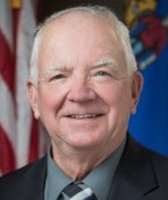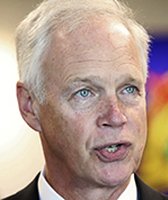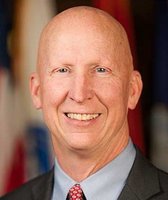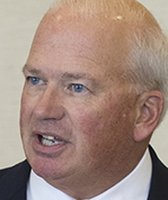Stand up for the facts!
Our only agenda is to publish the truth so you can be an informed participant in democracy.
We need your help.
I would like to contribute
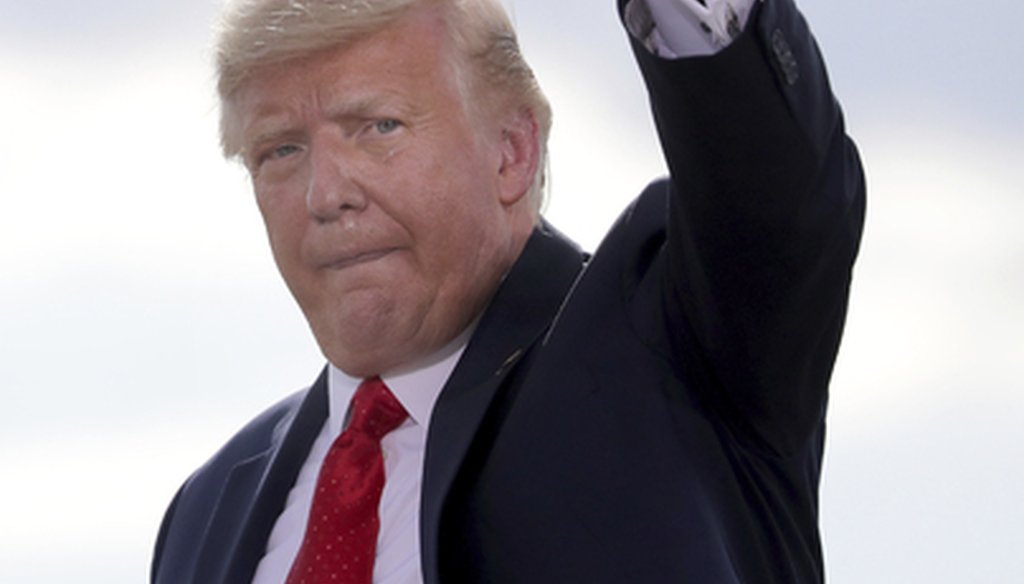
President Donald Trump waves as he leaves following a visit to Basler Flight Service on Monday, Aug. 17, 2020, at Wittman Regional Airport in Oshkosh, Wis. (Wm. Glasheen/The Post-Crescent via AP)
As the largely virtual Democratic National Convention launched from Milwaukee on August 17, 2020, President Donald Trump made his second stop of the summer in Wisconsin.
In an appearance in Oshkosh, he ran through many of his favorite talking points, mocking the "fake news" while touting his record on the economy, the coronavirus pandemic and trade. Here’s a rundown of some of his main claims.
RELATED: Fact-checking Trump’s June visit to Marinette
"We gave $28 billion to the farmers, and the farmers are doing well"
Deep in dairy country, Trump tried to make the case that his presidency has been good for farmers.
"Any farmers here, did I do a good job for you please?" he said, a comment followed by little crowd reaction. "I don’t hear any farmers complaining. We did a good job."
The federal government under Trump has indeed given billions to farmers, as we noted in a July 2020 fact check. The Market Facilitation Program paid out more than $14 billion in 2018 and 2019 to mitigate impacts from trade wars, and the Coronavirus Food Assistance Program — announced in April — is intended to provide up to $19 billion for farmers affected by the pandemic.
But even before the pandemic, farmers in Wisconsin were hardly "doing well."
In 2019 alone, Wisconsin lost 818 dairy farms, part of an accelerating decline in which about one-quarter of the state’s dairy farms have gone out of business since 2014. And farmers are struggling here more than elsewhere — Wisconsin led the nation with 57 bankruptcy filings in 2019, the highest level in a decade, according to the American Farm Bureau Federation.
"Before the virus … unemployment in Wisconsin had reached the lowest rate ever recorded"
This is close to true.
The U.S. Bureau of Labor Statistics shows the Wisconsin unemployment rate dipped as low as 3% in 2018, before rising slightly to 3.5% in the months before the pandemic hit in early 2020.
The agency has data online back to 1976, and there was just one period with numbers that low. Wisconsin posted 3% unemployment for several months in mid-1999, part of an extended stretch under 4% from 1995 to 2000.
So the lowest rate under Trump is equal to the lowest rate in recent history. But the rate had risen somewhat by the time the pandemic started.
"Our (COVID-19) numbers are better than almost all countries"
This is ridiculous.
There are plenty of metrics by which to compare the U.S. and the rest of the world, and the U.S. fares very poorly in just about all of them.
The U.S. has the most cases in the world — 5.6 million, or more than 2 million more than second-place Brazil — and is among the highest in cases per capita, according to data compiled by WorldoMeter.
Trump often says the U.S. only has more cases because it tests more (a claim PolitiFact has rated False and Pants on Fire in various iterations), but even removing testing from the equation shows the U.S. in a bad place.
Among the 20 countries most affected by COVID-19, the US is fourth-highest for COVID-19 deaths per capita, according to the Johns Hopkins University Coronavirus Resource Center.
In July 2020, PolitiFact National rated Trump False for claiming the U.S. has one of the lowest mortality rates in the world.
"We created 15,000 Wisconsin manufacturing jobs"
This number is in the ballpark if we’re only talking about the pre-coronavirus period. And even then, the trick is who should get credit for the trend.
The federal Bureau of Labor Statistics reports Wisconsin gained 18,000 manufacturing jobs from Trump’s inauguration in January 2017 until January 2019. That tally then dropped slowly until a recovery in December 2019, and the sharp drop as the pandemic took hold in April 2020.
But as it stands today, amid the pandemic, Wisconsin is currently down 16,000 manufacturing jobs from when Trump took office.
In Wisconsin, manufacturing jobs had been trending steadily up since 2010. So it’s not as if Trump oversaw a dramatic reversal.
Experts have told PolitiFact Wisconsin the manufacturing trends — up early in Trump’s term, then downward for a time before the pandemic — are impacted by any number of factors, including foreign competition, trade uncertainty, lack of clarity over Brexit and the political situations in Venezuela and Iran.
Dennis Winters, chief economist with the Wisconsin Department of Workforce Development, warned in November 2019 against giving Trump too much credit given that manufacturing jobs typically trend up and down with the economy, and Trump took office during an "expanding business cycle."
RELATED: Dissecting the spin on Wisconsin manufacturing numbers
"We gave you the biggest tax decrease in the history of our country"
We’ll lean on a fact-check from PolitiFact National that examined a largely identical claim. Here’s what they wrote in January.
Trump says this often, but it’s False. Trump is referring to the Tax Cuts and Jobs Act of 2017, which is projected to cut about $1.5 trillion in taxes over 10 years, or about $150 billion a year.
Several bills since the 1980s have provided larger tax cuts, according to a Treasury Department list of the biggest tax bills between 1940 and 2012, measured not only by contemporary dollars but also by inflation-adjusted dollars and as a percentage of the gross domestic product.
In inflation-adjusted dollars, the 2017 tax bill is the fourth-largest since 1940. And as a percentage of GDP, it ranks seventh.
Says U.S. farmers were "really being taken advantage of with Canada charging you a 287% tariff"
Touting the new United States-Mexico-Canada trade agreement, Trump circled back to a claim he made frequently in 2018 — though he usually used a 270% number then. PolitiFact National rated that figure Mostly True in 2018, assessing it this way:
After a small fixed quota of U.S. exports is reached, Canada imposes a tariff on any dairy products brought into the country, with the level varying a bit depending on the specific product. For instance, fluid milk is 241 percent, cheese is 245.5 percent, ice cream is 277 percent, cream is 292.5 percent, and butter is 298.5 percent.
Experts said Trump’s tweet is a reasonable mid-range estimate, and given the scale of these tariffs, "Trump's complaints have some basis in fact," said Munroe Eagles, director of Canadian studies at the State University of New York-Buffalo. …
That said, the United States has recently run a sizable trade surplus with Canada in dairy products, driven by a strong business in a milk product that was unaffected by the high tariffs. Trump also glosses over the fact that the United States imposes its own trade barriers on certain American-made products.
Our Sources
PolitiFact Wisconsin, Dems exaggerate in slamming Trump farm bailouts as "handout for large agricultural companies," July 2, 2020
Milwaukee Journal Sentinel, Wisconsin dairy farms: A portrait of loss, updated Jan. 6, 2020
American Farm Bureau Federation, The Verdict Is In: Farm Bankruptcies Up in 2019, Jan. 29, 2020
U.S Bureau of Labor Statistics, unemployment in Wisconsin, accessed Aug. 17, 2020
Johns Hopkins University, Mortality analysis, updated Aug. 17, 2020
Worldometer.com, COVID-19 coronavirus pandemic, updated Aug. 17, 2020
PolitiFact National, Donald Trump wrong to say U.S. has "one of the lowest mortality rates in the world" from COVID-19, July 20, 2020
PolitiFact National, Trump’s take on COVID testing gives short shrift to public health realities, June 17, 2020
PolitiFact National, Donald Trump wrong that greater testing is driving coronavirus case load, June 24, 2020
U.S Bureau of Labor Statistics, manufacturing in Wisconsin, accessed Aug. 17, 2020PolitiFact Wisconsin, Dissecting the spin on manufacturing numbers, Nov. 13, 2019
PolitiFact National, Fact-checking Donald Trump’s new video listing presidential achievements, Jan. 23, 2020
PolitiFact National, Donald Trump says Canada levies 270 percent tariff on dairy. That's basically right, June 13, 2018
















